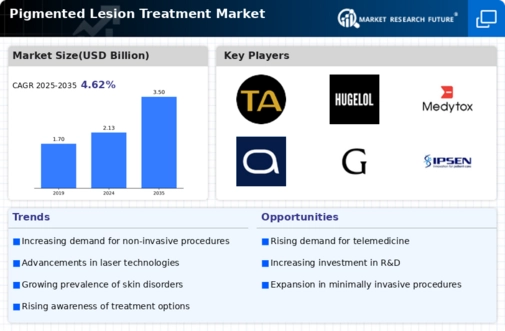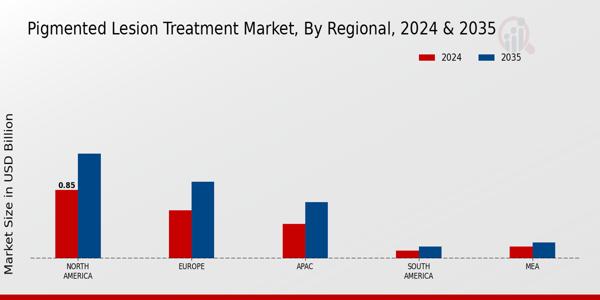Market Growth Projections
The Global Pigmented Lesion Treatment Market Industry is projected to experience substantial growth in the coming years. With an estimated market value of 2.13 USD Billion in 2024, the industry is expected to expand to 3.5 USD Billion by 2035. This growth trajectory indicates a compound annual growth rate of 4.62% from 2025 to 2035. Factors contributing to this growth include increasing incidences of skin disorders, advancements in treatment technologies, and a growing awareness of skin health. These dynamics suggest a robust market environment, with opportunities for innovation and investment in pigmented lesion treatments.
Rising Geriatric Population
The increasing geriatric population globally is a significant driver of the Global Pigmented Lesion Treatment Market Industry. Older adults are more susceptible to skin disorders due to age-related changes in skin structure and function. As the global population ages, the incidence of pigmented lesions is expected to rise, leading to greater demand for treatment options. This demographic shift necessitates the development of targeted therapies that cater to the unique needs of older patients. Consequently, the market is poised for growth, as healthcare systems adapt to provide effective solutions for this expanding patient demographic.
Growing Awareness and Education
Increased awareness and education regarding skin health are pivotal in shaping the Global Pigmented Lesion Treatment Market Industry. Campaigns aimed at educating the public about the risks associated with untreated pigmented lesions have led to higher consultation rates with dermatologists. This heightened awareness encourages early detection and treatment, which is crucial for conditions that could lead to skin cancer. As a result, the market is likely to experience growth, with a projected compound annual growth rate of 4.62% from 2025 to 2035. This trend underscores the importance of public health initiatives in driving demand for effective treatment options.
Increasing Incidence of Skin Disorders
The rising prevalence of skin disorders globally drives the Global Pigmented Lesion Treatment Market Industry. Conditions such as melasma, lentigines, and other pigmented lesions are becoming more common due to factors like sun exposure and environmental pollutants. For instance, the World Health Organization indicates that skin cancer rates are increasing, which correlates with the demand for effective treatment options. As awareness grows, patients seek medical intervention, contributing to market expansion. The industry is projected to reach 2.13 USD Billion in 2024, reflecting the urgent need for innovative therapies to address these conditions.
Regulatory Support and Approval for New Treatments
Regulatory support for the approval of new treatments is crucial for the Global Pigmented Lesion Treatment Market Industry. Government agencies are increasingly recognizing the need for effective therapies to address the growing burden of pigmented lesions. Streamlined approval processes for innovative treatments can facilitate quicker access to new therapies for patients. This regulatory environment encourages pharmaceutical companies to invest in research and development, leading to a broader range of treatment options. As a result, the market is likely to benefit from the introduction of novel therapies, enhancing overall treatment efficacy and patient outcomes.
Technological Advancements in Treatment Modalities
Technological innovations in treatment modalities are significantly influencing the Global Pigmented Lesion Treatment Market Industry. Advances in laser therapy, cryotherapy, and topical agents have improved treatment efficacy and patient outcomes. For example, the introduction of fractional laser technology has revolutionized the way pigmented lesions are treated, offering less invasive options with quicker recovery times. These advancements not only enhance patient satisfaction but also attract more individuals seeking treatment. As a result, the market is expected to grow, with projections indicating a value of 3.5 USD Billion by 2035, driven by ongoing research and development in dermatological treatments.










